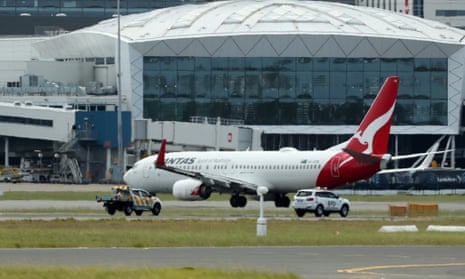“Effective decision-making” from a Qantas flight crew has been found to have contributed to the safe landing of a flight which issued a mayday call when one of its two engines abruptly shut down over the Tasman sea earlier this year.
The Australian Transport Safety Bureau, in its investigation into the Qantas flight 144 from Auckland to Sydney on 18 January, also found voice recordings in the aircraft’s black box were “inadvertently overwritten” during maintenance after the plane landed safely in Sydney.
One hour and 24 minutes into the flight, which departed Auckland airport at 2.30pm local time, flight crew reported hearing a “pop sound”, the ATSB report found, as the Boeing 737-838 with 143 passengers was cruising at 36,000ft.
After hearing the sound, the crew noticed the autopilot and auto throttle disengaging, which triggered associated warning lights and a horn.
Once they had identified that the left engine was not operating, the crew broadcast a mayday call. Air traffic controllers in Brisbane, who monitor airspace over the Tasman sea, gave the pilots permission to descend to 24,000ft.
Cabin crew then “heard a noise and felt the aircraft yawing in a manner they described as ‘not normal’,” the ATSB report said.
As the pilots consulted the cabin safety manager and explained they were unsure what had caused the engine outage, crew noticed the cabin temperature “getting quite warm”, with air-conditioning affected by the outage.
A decision was made to only communicate the outage to flight and cabin crew, the report found.
The pilots attempted to restart the engine but aborted this when a part in the engine was not functioning as required for a restart.
The crew then prepared for a single-engine landing, and while Norfolk Island was about 150km closer, a decision was made to land at Sydney due to the required deviation and “changeable weather and operation conditions” at Norfolk Island’s small airport.
This decision was praised by ATSB director of transport safety, Kerri Hughes.
“Sydney Airport was on the aircraft’s direct route, had favourable weather conditions forecast, had an extensive emergency response, and a straight-in approach on a very long runway,” Hughes noted.
“The decision to continue to Sydney ensured no additional risk was added to an already high workload situation,” she said.
Just before beginning its descent, the mayday call was downgraded to “possible assistance needed”.
after newsletter promotion
At this point, the captain informed passengers about “issues with one engine that was affecting the air-condition and some electrical systems”, and warned them that emergency services would greet the plane on the tarmac when they landed.
Only after an “uneventful landing” in Sydney at about 3.26pm local time did the captain inform passengers of the engine failure.
Passengers walking into Sydney airport later reported surprise at the presence of media at the arrival gate; the plane’s mayday call and subsequent landing had been widely reported in real time.
The ATSB investigation of the engine found that “separation of the radial driveshaft led to a mechanical discontinuity between the engine core and accessory gearbox”.
“This resulted in loss of the accessory gearbox-driven main fuel pump pressure and uncommanded shutdown of the left engine. In addition, the failed driveshaft prevented the engine from being restarted in-flight,” the ATSB report found.
Separately, when the ATSB went to download data from the black box – which records flight data and cockpit audio – at its facilities in Canberra, it found the voice recordings had been overwritten.
“As the aircraft had been powered for maintenance activity following arrival at Sydney Airport, without the cockpit voice recorder being isolated, the audio data recorded during the incident flight was overwritten and not available for this investigation,” the ATSB said.
Qantas has addressed their procedures “to prevent inadvertent overwrite” of black boxes in the future.
